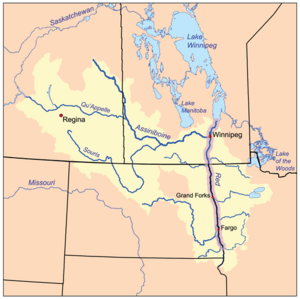Battle of Grand Coteau (North Dakota) facts for kids
Quick facts for kids Battle of Grand Coteau (North Dakota) |
|||||||
|---|---|---|---|---|---|---|---|
|
|||||||
| Belligerents | |||||||
| Métis buffalo hunters | Sioux (Yanktonai) | ||||||
| Commanders and leaders | |||||||
| Jean Baptiste Falcon | Chief Medicine Bear | ||||||
| Strength | |||||||
| 67-77 | 2,000 | ||||||
| Casualties and losses | |||||||
| 1 dead 12 horses killed |
15-80 dead 65 horses killed |
||||||
The Battle of Grand Coteau (North Dakota) was a fight between Métis buffalo hunters and the Sioux people. It happened in North Dakota on July 13 and 14, 1851. The Métis won this battle. It was the last big battle between these two groups.
The Métis people lived near the Red River of the North in what is now Winnipeg, Manitoba, Canada. Every year, they went on a big buffalo hunt. They would plant their crops in spring. Then, they would leave for the hunt in June with their families. They returned in August with dried meats like pemmican.
The Sioux often bothered the Métis during these hunts. So, the Métis from different settlements traveled in large groups. This helped them stay safe and defend themselves.
Contents
What Was the Grand Coteau Battle?
The 1851 buffalo hunt started as usual. The Métis groups from St. Boniface and Pembina met up on June 16. Then, they traveled west to meet the St. François Xavier group on June 19.
In total, there were about 1,300 people. They had 1,100 carts and 318 hunters. The groups hunted separately. But they planned to join forces if the Sioux attacked. They split into three groups, each about 20 to 30 miles apart. They all moved in the same direction.
How the Battle Began
The St. François Xavier group was led by Jean Baptiste Falcon. A missionary named Father Louis-François Richer Laflèche was also with them. This group had 200 carts and 67 hunters, plus women and children.
On July 12, their scouts were in North Dakota. They were on the Grand Coteau of the Missouri. The scouts saw a large group of Sioux warriors. Five scouts rode back to warn their camp. But they met 20 Sioux warriors who surrounded them. Two scouts managed to escape under fire. Three were captured. The next day, two of the captives escaped, but one was killed.
On Sunday, July 13, the Sioux attacked the Métis camp.
The Métis Defense and Victory
Father Laflèche played a special role in the battle. He wore his religious clothes, including a black robe and a white vestment. He helped the camp commander, Jean Baptiste Falcon. Together, they led the defense against about 2,000 Sioux fighters. Father Laflèche held up a crucifix during the fight.
The Sioux attacked for two days, July 13 and 14. But the Métis held strong. The Sioux eventually left. They believed that the Great Spirit was protecting the Métis. This is why the Métis won the battle.
Images for kids
-
Paul Kane's oil painting showing a Métis buffalo hunt in Dakota in June 1846





